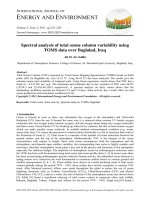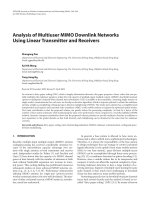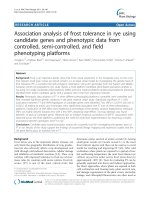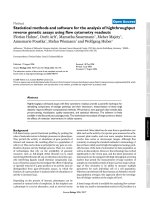Analysis of cardiac and epileptic signals using higher order spectra
Bạn đang xem bản rút gọn của tài liệu. Xem và tải ngay bản đầy đủ của tài liệu tại đây (3.27 MB, 205 trang )
ANALYSIS OF CARDIAC AND EPILEPTIC
SIGNALS USING HIGHER ORDER SPECTRA
by
Chua Kuang Chua
B.Eng (Hons), MSc (Dist)
PhD Thesis
Submitted In Partial Fulfilment of the
Requirements for the Degree of
Doctor of Philosophy
at the
Queensland University of Technology
March 2010
Abstract
The theory of nonlinear dyamic systems provides some new methods to handle
complex systems. Chaos theory offers new concepts, algorithms and methods for processing,
enhancing and analyzing the measured signals. In recent years, researchers are applying the
concepts from this theory to bio-signal analysis. In this work, the complex dynamics of the
bio-signals such as electrocardiogram (ECG) and electroencephalogram (EEG) are analyzed
using the tools of nonlinear systems theory.
In the modern industrialized countries every year several hundred thousands of
people die due to sudden cardiac death. The Electrocardiogram (ECG) is an important biosignal representing the sum total of millions of cardiac cell depolarization potentials. It
contains important insight into the state of health and nature of the disease afflicting
the heart. Heart rate variability (HRV) refers to the regulation of the sinoatrial node, the
natural pacemaker of the heart by the sympathetic and parasympathetic branches of the
autonomic nervous system. Heart rate variability analysis is an important tool to observe the
heart's ability to respond to normal regulatory impulses that affect its rhythm. A computerbased intelligent system for analysis of cardiac states is very useful in diagnostics and disease
management. Like many bio-signals, HRV signals are non-linear in nature. Higher order
spectral analysis (HOS) is known to be a good tool for the analysis of non-linear systems and
provides good noise immunity. In this work, we studied the HOS of the HRV signals of
normal heartbeat and four classes of arrhythmia. This thesis presents some general
characteristics for each of these classes of HRV signals in the bispectrum and bicoherence
plots. Several features were extracted from the HOS and subjected an Analysis of Variance
i
(ANOVA) test. The results are very promising for cardiac arrhythmia classification with a
number of features yielding a p-value < 0.02 in the ANOVA test. An automated intelligent
system for the identification of cardiac health is very useful in healthcare technology. In this
work, seven features were extracted from the heart rate signals using HOS and fed to a
support vector machine (SVM) for classification. The performance evaluation protocol in this
thesis uses 330 subjects consisting of five different kinds of cardiac disease conditions. The
classifier achieved a sensitivity of 90% and a specificity of 89%. This system is ready to run
on larger data sets.
In EEG analysis, the search for hidden information for identification of seizures has a
long history. Epilepsy is a pathological condition characterized by spontaneous and
unforeseeable occurrence of seizures, during which the perception or behavior of patients is
disturbed. An automatic early detection of the seizure onsets would help the patients and
observers to take appropriate precautions. Various methods have been proposed to predict the
onset of seizures based on EEG recordings. The use of nonlinear features motivated by the
higher order spectra (HOS) has been reported to be a promising approach to differentiate
between normal, background (pre-ictal) and epileptic EEG signals. In this work, these
features are used to train both a Gaussian mixture model (GMM) classifier and a Support
Vector Machine (SVM) classifier. Results show that the classifiers were able to achieve
93.11% and 92.67% classification accuracy, respectively, with selected HOS based features.
About 2 hours of EEG recordings from 10 patients were used in this study.
This thesis introduces unique bispectrum and bicoherence plots for various cardiac
conditions and for normal, background and epileptic EEG signals. These plots reveal distinct
patterns. The patterns are useful for visual interpretation by those without a deep
ii
understanding of spectral analysis such as medical practitioners. It includes original
contributions in extracting features from HRV and EEG signals using HOS and entropy, in
analyzing the statistical properties of such features on real data and in automated
classification using these features with GMM and SVM classifiers.
iii
Contents
ABSTRACT .......................................................................................................................................I
CONTENTS.............................................................................................................. IV
LIST OF FIGURES ................................................................................................. IX
LIST OF TABLES ..................................................................................................XII
STATEMENT OF AUTHORSHIP ..................................................................... XIV
ACKNOWLEDGEMENTS ...................................................................................XV
PUBLICATIONS .................................................................................................. XVI
CHAPTER 1 INTRODUCTION.............................................................................1
1.1
Introduction .........................................................................................................1
1.2
Motivation ...........................................................................................................3
1.3
Objectives ............................................................................................................5
1.4
Contributions .......................................................................................................5
CHAPTER 2 BIOSIGNALS USED (HEART RATE AND EEG SIGNALS).....7
2.1
General ................................................................................................................7
2.2
Electrocardiography ............................................................................................8
2.2.1 Data Acquisition ........................................................................................9
2.2.2 Steps in ECG Analysis.............................................................................12
2.2.3 Preprocessing Of ECG .............................................................................13
2.2.4 Noise Filtering Technique........................................................................18
2.2.5 QRS Complex Detection..........................................................................20
2.2.6 QRS Detection Algorithm........................................................................20
iv
2.2.7 Band Pass Integer Filter ...........................................................................22
2.2.8 Low Pass Integer Filter ............................................................................23
2.2.9 High Pass Integer Filter............................................................................23
2.2.10 Derivative ..............................................................................................24
2.2.11 Squaring Function..................................................................................24
2.2.12 Moving Window Integral ......................................................................25
2.2.13 QRS Detection Using Adaptive Thresholds ..........................................25
2.2.14 Cardiac Abnormalities ...........................................................................26
2.2.15 Heart Rate Variability (HRV)................................................................32
2.3
Electroencephalogram .......................................................................................33
2.3.1 EEG Recording Methods .........................................................................34
2.3.2 Advantages of monopolar recording........................................................35
2.3.3 Advantages of bipolar recording..............................................................35
2.3.4 EEG Lead Positioning..............................................................................35
2.3.5 Classification of EEG Rhythms ...............................................................36
2.3.6 Delta Waves .............................................................................................36
2.3.7 Theta Waves.............................................................................................36
2.3.8 Alpha Waves ............................................................................................37
2.3.9 Beta Waves ..............................................................................................37
2.3.10 Uses of EEG ..........................................................................................37
2.3.11 Epileptic EEG Signal.............................................................................38
2.3.12 Different types of EEG Signal..............................................................41
CHAPTER 3 LITERATURE REVIEW...............................................................44
3.1
Introduction .......................................................................................................44
3.2
HOS and features derived from HOS................................................................47
3.2.1 Higher order spectra.................................................................................47
3.2.2 Frequency Domain Definition and Properties .........................................51
3.2.3 Estimation of Higher-order spectra..........................................................54
v
3.3
ANALYSIS USING HOS FEATURES............................................................55
3.3.1 Bispectrum, Bicoherence and quadratic phase coupling ........................55
3.4
Application of HOS on various signals .............................................................64
3.4.1 Electroencephalogram (EEG) analysis ....................................................64
3.4.2 ECG and HRV analysis............................................................................66
3.5
Summary ...........................................................................................................68
CHAPTER 4 CLASSIFIERS.................................................................................69
4.1
Gaussian mixture models (GMM):....................................................................69
4.2
Support Vector Machine (SVM): ......................................................................71
CHAPTER 5 CARDIAC STATE DIAGNOSIS USING HIGHER
ORDER SPECTRA .........................................................................................75
5.1
Introduction .......................................................................................................75
5.2
Data and Classes................................................................................................78
5.3
Methods used for analysis .................................................................................78
5.4
Statistical Analysis ............................................................................................81
5.5
Results ...............................................................................................................81
5.6
Discussion .........................................................................................................90
5.6.1 The scope of the study .............................................................................91
5.7
Conclusion.........................................................................................................95
vi
CHAPTER 6 ANALYSIS OF EPILEPTIC EEG SIGNALS USING HIGHER
ORDER SPECTRA ..................................................................................................96
6.1
Data ...................................................................................................................96
6.2
Methods .............................................................................................................97
6.3
Quantitative Analysis ........................................................................................97
6.4
Results ...............................................................................................................98
6.5
Discussion .......................................................................................................105
6.6
Conclusion.......................................................................................................107
CHAPTER 7 CARDIAC HEALTH DIAGNOSIS USING HIGHER ORDER
SPECTRA AND SUPPORT VECTOR MACHINE ..................................108
7.1
Introduction .....................................................................................................108
7.2
Data Acquisition Process.................................................................................111
7.2.1 Preprocessing .........................................................................................112
7.3
Methods Used..................................................................................................113
7.4
Quantitative analysis .......................................................................................113
7.5
Support Vector Machine (SVM) Classifier.....................................................113
7.6
Principal Component Analysis ........................................................................114
7.7
Test vector generation .....................................................................................115
7.8
Results .............................................................................................................115
7.9
Discussion .......................................................................................................126
7.10 Conclusion.......................................................................................................130
vii
CHAPTER 8 AUTOMATIC IDENTIFICATION OF EPILEPTIC EEG
SIGNALS USING HIGHER ORDER SPECTRA .....................................131
8.1
Introduction .....................................................................................................131
8.2
Data .................................................................................................................134
8.3
HOS based features .........................................................................................134
8.4
Classifiers ........................................................................................................136
8.4.1 Test vector generation............................................................................136
8.4.2 Performance comparison and Receiver Operating Characteristics
(ROC).....................................................................................................136
8.5
Results .............................................................................................................137
8.6
Discussion .......................................................................................................149
8.7
Conclusion.......................................................................................................155
CHAPTER 9 CONCLUSION AND FUTURE WORK.....................................156
9.1
Conclusion.......................................................................................................156
9.2
Future work .....................................................................................................157
REFERENCES........................................................................................................159
viii
List of Figures
Figure 2.1 Genesis of ECG [Athayde 1981]..............................................................10
Figure 2.2 ECG lead configuration [ Carr et al., 2000] ..............................................11
Figure 2.3 The ECG signal. ........................................................................................13
Figure 2.4 Result of power line interference removal. (a) Original signal with
power line interference (b) Output of power line interference filter. ..................15
Figure 2.5 Algorithm to remove the baseline wander................................................17
Figure 2.6 Results of baseline wander algorithm. (a) Original signal (b) Output
of baseline wander filter. .....................................................................................18
Figure 2.7 Block diagram of the QRS detector. z(n) is the time averaged signal.
y(n) is the band passed ECG. x(n) is the differentiated ECG.............................21
Figure 2.8 High pass filter. ........................................................................................23
Figure 2.9 Normal ECG signal. ..................................................................................28
Figure 2.10 Congestive heart failure ECG Signal. ..............................................28
Figure 2.11 Atrial fibrillation ECG signal. .................................................................29
Figure 2.12 Ventricular fibrillation ECG signal. ........................................................29
Figure 2.13 Preventricular contraction ECG signal..............................................29
Figure 2.14 Left bundle branch block ECG signal. ...............................................30
Figure 2.15 Complete heart block ECG signal. .....................................................30
Figure 2.16 Ischemic/Dilated cardiomyopathy ECG signal. ......................................31
Figure 2.17 Sick Sinus Syndrome ECG signal. ......................................................31
Figure 2.18 EEG lead positioning system. .............................................................36
Figure 2.19 A taxonomy of seizures based upon classifications from the
International League Against Epilepsy (1985). ............................................38
Figure 2.20 Scheme of intracranial electrodes implanted for presurgical
evaluation of epilepsy patients. Depth electrodes were implanted
symmetrically into the hippocampal formations (top). These are the
locations where the epileptic EEGs were collected. ....................................42
Figure 2.21 EEG Signals (a) normal (b) pre-ictal and (c) seizure. .............................42
ix
Figure 3.1 Non-redundant region of computation of the bispectrum of a discretetime signal assuming that the sampling interval is 1 and the Nyquist
frequency is thus radians/second. ...................................................................54
Figure 3.2 Bicoherence noise plots (a) Gaussian (b) Generalized extreme value
noise with 100 blocks of data and each block 256 samples. ...............................58
Figure 3.3 Typical heart rate signal of normal subject. ..............................................59
Figure 3.4 Plots of (a) bispectrum (b) bicoherence of Figure 3.3..........................60
Figure 3.5 Region of computation of the bispectrum for real signals. Features are
calculated by integrating the bispectrum along the dashed line with slope=a.
Frequencies are shown normalized by the Nyquist frequency. ...........................63
Figure 4.1 Working of SVM algorithm ..................................................................71
Figure 5.1 Bispectrum and bicoherence of Normal heart rate. ................................86
Figure 5.2 Bispectrum and bicoherence of heart rate with Ectopic beat. ...............86
Figure 5.3 Bispectrum and bicoherence of heart rate with AF. ..................................87
Figure 5.4 Bispectrum and bicoherence of heart rate with CHB................................87
Figure 5.5 Bispectrum and bicoherence of heart rate with SSS-III ............................88
Figure 5.6 Bispectrum and bicoherence of heart rate with Isc\Dil.
Cardiomyopathy ..................................................................................................88
Figure 5.7 Bispectrum of heart rate with LBBB.........................................................89
Figure 5.8 Bispectrum and bicoherence of heart rate with VF. ..................................89
Figure 5.9 Mean magnitudes of the Bispectrum and one standard deviation for
each class .............................................................................................................90
Figure 5.10 Bicoherence plots of different records of heart rate with PVC ...............93
Figure 5.11 Bicoherence plots of different records of heart rate with Isc/Dil
Cardiomyopathy ..................................................................................................94
Figure 6.1 Average bispectrum, bicoherence( b95% 0.015 ) and contour plots
of 100 normal EEG signals. ..............................................................................101
Figure 6.2 Average bispectrum, bicoherence ( b95% 0.015 ) and contour plots
of 100 pre-ictal EEG signals. ...........................................................................103
Figure 6.3 Average bispectrum, bicoherence( b95% 0.015 ) and contour plots
of 100 ictal EEG signals....................................................................................104
Figure 6.4 Cluster plot of 3 features (P1, P2 and Mave ).............................................105
Figure 7.1 Distributions of various features extracted from the bispectrum
(a) bispectrum entropy 1 (P1), (b) bispectrum entropy 2 (P2), (c) sum
x
of the logarithmic amplitudes of the bispectrum (H1), (d) sum of
logarithmic amplitudes of diagonal elements (H2)....................................119
Figure 7.1 Distributions of various features extracted from the bispectrum
(e) first order spectral moment of amplitudes of diagonal elements in
the bispectrum (H3), (f) the weighted centre of bispectrum frequency
index 1 (f1m), (g) the weighted centre of bispectrum frequency index
2 (f2m).................................................................................................................120
Figure 7.2 (a) PCA analysis of invariant features P(a) projected unto 3 main
principal components.........................................................................................123
Figure 7.2 (b) PCA analysis of line integral B2 projected unto 3 main principal
components (PCs)..............................................................................................124
Figure 7.2 (c) PCA analysis of HOS features projected unto 3 main principal
components (PCs)..............................................................................................125
Figure 8.1 A cluster plot of 3 features (P1, P2 and Mave ).....................................135
Figure 8.2 Comparison of ROC curves for the two classifiers: (a) ROC curves of
GMM classifier with different combinations of features (b) ROC curves of
SVM classifier with different combinations of features (c) ROC curves of
GMM classifier for Normal, Epileptic and Pre-ictal EEG, and (d) ROC
curves of SVM classifier for Normal, Epileptic and Pre-ictal EEG..................145
Figure 8.3 Percentage of classification accuracy for different classifiers. .......148
xi
List of Tables
Table 5.1 ECG Data for different cardiac health states. .............................................84
Table 5.2 Invariant features, Mean Bispectrum Magnitude and Phase entropy,
Bispectral Entropy1 and 2. Entries in columns other than the last two
correspond to mean and standard deviation. .......................................................85
Table 6.1 Results of various HOS parameters for normal, pre ictal and
epileptic EEG signals........................................................................................100
Table 7.1 Numbers of ECG data sets for different cardiac health states. .......112
Table 7.2 Results of ANOVA on various bispectral features. Entries in the
columns other than the last correspond to mean and standard deviation. .........117
Table 7.3 Confusion matrix for five different classes of arrhythmia with a
SVM classifier..................................................................................................118
Table 7.4 Classification accuracy for five different classes of arrhythmia
with a SVM classifier......................................................................................118
Table 7.5 Sensitivity, Specificity, and Positive Predictive Value for the
SVM classifier. Entries to the left are the numbers of True and False
negatives and the True and False positives. ...............................................121
Table 7.6 Comparison of arrhythmia classification with non-linear feature. ...........128
Table 8.1 Values of various HOS parameters (in mean ± standard deviation) for
normal, pre-ictal and epileptic EEG signals (p<0.0001). .................................138
Table 8.2 Percentage of classification of GMM and SVM classifiers with
different combination of features (700 training data and 300 test data
in each case).....................................................................................................138
Table 8.3 Results of ROC for the two classifiers with features P1, P2 and
Mave....................................................................................................................141
Table 8.4 Basic mathematical formulae for classifier analysis. ........................141
Table 8.5 Values of various spectral based features (in mean±standard
deviation) for normal, pre ictal and epileptic EEG signals (p<0.0001). ..146
Table 8.6 Percentage of classification accuracy of classifiers with power spectral
features (P1, P2, Mave). .......................................................................................147
xii
Table 8.7 Percentage of classification accuracy of classifiers with HOS features
(P1, P2, Mave). .....................................................................................................147
Table 8.8 Percentage of classification accuracy for different classifiers in mean ±
standard deviation ( p<0.0001)..........................................................................148
Table 8.9 Comparison of some of the recent works in epilepsy detection. .............152
xiii
Statement of Authorship
The work in this thesis has not been previously submitted for a degree or diploma at
any other higher education institution. To the best of my knowledge and belief, the thesis
contains no material previously published or written by another person except where due
reference is made.
Signed: ________________________
Date:_________________________
xiv
Acknowledgements
I would like to express my gratitude to all those who gave me the possibility to pursue
this research. I wish to express my deep gratitude to my supervisor Prof. Vinod Chandran for
his invaluable guidance, encouragement and direction throughout this work. I would also
like to thank Dr. Lim Choo Min, director, Electronic and Computer Engineering (ECE)
division, NgeeAnn Polytechnic for his help, support, interest and valuable suggestions. Many
thanks for Dr Rajendra Acharya U for many of his interesting discussions and suggestions
towards my research. Thanks for Dr Duncan Campbell for proof reading my thesis and his
invaluable suggestions to improve the thesis. Special thanks to my wife, Jenny Pang for her
constant support and patience throughout my thesis. I would not have been able to complete
this, but for her co-operation. Finally, I want to thank, everyone who have, in one way or
another, helped me to conduct this research.
xv
Publications
Journal Papers
[1]
Chua KC, Chandran V, Acharya UR, Lim CM. Application of higher order
spectra to identify epileptic EEG. Journal of Medical Systems, Springer 2010 (in
Press).
[2]
Chua KC, Chandran V, Acharya UR, Lim CM. Cardiac health diagnosis using
higher order spectra and support vector machine. Open Access Medical
Informatics Journal 2009 (in Press).
[3]
Chua KC, Chandran V, Acharya UR, Lim CM. Automatic Identification Of
Epileptic EEG signals Using Higher Order Spectra. International Journal of
Engineering in Medicine 2009; 223(4): 485-495.
[4]
Chua KC, Chandran V, Acharya UR, Lim CM. Analysis of epileptic EEG signals
using higher order spectra. Journal of Medical & Engineering Technology, UK,
33(1), 2009, 42-50.
[5]
Chua KC, Chandran V, Acharya UR, Lim CM. Computer- based analysis of
cardiac state using entropies, recurrence plots and Poincare geometry. Journal of
Medical & Engineering Technology 2008; 32(4): 263-272.
xvi
[6]
Chua KC, Chandran V, Acharya UR, Lim CM, Cardiac State Diagnosis Using
Higher Order Spectra of Heart Rate Variability, Journal of Medical &
Engineering Technology 2008; 32(2): 145-155.
[7]
Chua KC, Chandran V, Acharya UR, Lim CM, Application Of Higher order
Statistics/spectra for Biomedical Signals – A Review , Journal of Medical
Engineering & Physics (in Press).
Conference Papers
[1]
Chua KC, Chandran V, Acharya UR, Lim CM. Higher Order Spectra Analysis for
Heart Rate Variability. Proceedings of 15th International conference on
mechanics in medicine and biology, Singapore 2006; 262-267.
[2]
Chua KC, Chandran V, Acharya UR, Lim CM. Analysis of epileptic EEG signals
using higher order spetra. Proceedings of 15th International conference on
mechanics in medicine and biology, Singapore 2006; 303-308.
[3]
Chua KC, Chandran V, Acharya UR, Lim CM, Higher Order Spectral (HOS)
Analysis Of Epileptic EEG Signals, 29th IEEE-EMBS-2007, Lyon, August 2007.
[4]
Chua KC, Chandran V, Acharya UR, Lim CM, Automatic identification of
epilepsy by HOS and power spectrum parameters using EEG signals: A
comparative study, 29th IEEE-EMBS-2008, Vancouver, August 2008.
xvii
[5]
Chua KC, Chandran V, Acharya UR and Lim CM, Higher Order Spectra based
Support Vector Machine for Arrhythmia Classification, ICBME 2008 3–6
December 2008 Singapore.
xviii
Chapter 1 Introduction
1.1
INTRODUCTION
Computer technology has an important role in structuring biological systems. The
explosive growth of high performance computing techniques in recent years, with regard
to the development of good and accurate models of biological systems, has contributed
significantly to new approaches to fundamental problems of modeling transient behavior
of biological systems.
The importance of biological time series analysis, which exhibits typically
complex dynamics, has long been recognized in the area of non-linear analysis. Several
features have been proposed to detect hidden important dynamical properties of
physiological phenomena generating the signals. These nonlinear dynamical techniques
are based on the concept of chaos which has been applied to many areas including the
areas of medicine and biology.
A great deal of attention has been focused recently on the extraction of dynamical
information from chaotic time series [Broomhead et al., 1986; Simm et al., 1987; Denker
et al., 1986]. Chaos is the state in which a nonlinear dynamical system exhibits bounded
motion, with exponential sensitivity to initial conditions, in that initially neighboring
states of a chaotic system diverge exponentially as the system evolves forward in time
[Guckenheimer et al., 1983]. Chaotic time series analysis has greatly enhanced the
understanding of chaos in experimental systems by allowing multidimensional dynamical
information to be recovered from a time series of measurements of a single variable
[Broomhead et al., 1986; Simm et al., 1987; Denker et al., 1986]. This is usually done
using the method of time delay embedding, which allows the recovery of information
from all degrees of freedom which are coupled to the observable [Broomhead et al.,
1
1986]. This allows the strange attractor of a chaotic dynamical system to be extracted
from a time series of measurements of a single variable. The simplicity of the technique
and the accessibility of experimental time series have encouraged the rapid exploration of
numerous fields as varied as plasma fluctuations [Simm et al., 1987], climatic variations
[Essex et al., 1990] and non-equilibrium chemical systems [Roux et al., 1983].
Recently, the nonlinear techniques have been used to analyze physiological
signals: heart rate, nerve activity, renal blood flow, arterial pressure, EEG and respiratory
signals [Kannathal et al, 2004, Acharya et al, 2004a, Garret et al, 2003, Yuru et al, 2004].
To investigate the time-varying spectral characteristics of the underlying process, most of
the methods often begin by computing the time variation of the common statistical
properties of the process [Roberto et al., 1995; Kaplan, 1999; Laurent et al., 1998].
However, these methods all assume that piecewise first-order or second-order stationarity
is satisfied for each segment of the observation after segmentation. In practice, many
medical signals show significant nonlinear and non-Gaussian characteristics, such as the
presences of nonlinear effects of phase coupling among the signal frequency components
[Shen et al., 2000; Ning, 1993; Ning et al., 1990; Husar et al., 1997]. The methods based
on spectral analysis fail to properly deal with the nonlinearity and non-Gaussianity of the
processes, but higher order spectra (HOS) allow us to effectively process these signals to
obtain their higher-order statistics. Bispectral estimation has been shown to be a very
useful tool for extracting the degree of quadratic phase coupling (QPC) between
frequency components of the process.
In this work, HOS are applied to biosignals such as electrocardiogram (ECG) and
electroencephalogram (EEG). The ECG signal is the electrical signal generated by the
heart’s muscle measured on the skin surface of the body. The EEG signal represents the
time series that maps the voltage corresponding to neurological activity of the brain as a
2
function of time. These bio-signals are essentially non-stationary signals; they display a
fractal like self-similarity. They may contain indicators of current disease, or even
warnings about impending diseases. The indicators may be present at all times or may
occur at random in the time scale. However, to (study and) pinpoint anomalies in
voluminous data collected over several hours is strenuous and time consuming.
Therefore, computer based analytical tools for in-depth study and classification of data
over day long intervals can be very useful in diagnostics.
1.2
MOTIVATION
ECG has a basic role in cardiology since it consists of effective simple
noninvasive low cost procedures for the diagnosis of cardiac disorders that have high
epidemiological incidence and are very relevant for their impact on patient life and social
costs. Pathological alterations observable by ECG are Cardiac rhythm disturbances (or
arrhythmia), Dysfunction of myocardial blood perfusion (or cardiac ischemia), Chronic
alteration of the mechanical structure of the heart. Cardiac rhythm disturbances are
considered to lead to life threatening conditions. Thus the detection of abnormalities in
intensive care patients is very essential and critical. Recently a lot of research is being
done for automating the abnormality detection applying various engineering methods and
non-conventional techniques. Especially in the scenario of continuous monitoring of ECG
in intensive care units, automatic analysis of ECG and abnormality detection is very
helpful, as it will be an aid to the clinical staff in the absence of the doctor. It will also
help the doctor to diagnose and act faster in case of emergency conditions. Designing
low cost, high performance, simple to use and portable equipment for ECG offering a
combination of diagnostic features seem to be a global pursuit. Such equipment should
embed and integrate several techniques of data analysis such as signal processing, pattern
3
detection and recognition, decision support and human computer interaction.
Thus
computerized methods are to be applied for detection and classification of abnormalities.
Epilepsy is a pathological condition characterized by spiky patterns in continuous
EEG and seizure at times. Approximately one percent of the world’s population has
epilepsy, one third of whom have seizures not controlled by medications [Hauser et al.,
1990; Kandel et al., 1991]. Individuals with epilepsy suffer considerable disability from
seizures and resulting injuries, the stigma and social isolation attached to having seizures,
and from side effects of medical and other therapies. Some patients, whose seizures
reliably begin in one discrete region, usually in the mesial (middle) temporal lobe, may be
cured by epilepsy surgery. This requires removing large volumes of brain tissue, due to
the lack of a reliable method for pinpointing the location of seizure onset and the
pathways through which seizures spread. Successful surgical treatment of focal epilepsies
requires exact localization of the epileptic focus and its delineation from functionally
relevant areas. For this purpose, different pre-surgical evaluation methodologies are
currently in use [Engel et al., 1998]. Neurological and neuropsychological examinations
are complemented by neuro-imaging techniques that try to identify potential
morphological correlates. Currently for localization of the epileptic focus is to record the
patient’s spontaneous habitual seizure using electroencephalography. Depending on the
individual occurrence of seizures this task requires long lasting and continuous recordings
of EEG. In case of ambiguous scalp EEG findings, invasive recordings of
electrocorticogram and stereo-EEG via implanted depth electrodes are used. This
procedure is time consuming and offers greater risk to the patient. Thus reliable EEG
analysis techniques are required to localize and to demarcate the epileptic focus.
4
1.3
OBJECTIVES
The present work is to perform nonlinear time series analysis on biosignals and
use support vector machine and Gaussian Mixtures model techniques to classify and
model the biosignals. In this work, the biosignals considered are ECG and EEG. Various
milestones in this work are
To establish an appropriate and relevant set of HOS features to detect various
cardiac abnormalities from the ECG signals.
To analyze EEG signals and to identify set of HOS features that distinguish
different types of EEG, specifically the normal, background (preictal) and
epileptic (ictal) EEG.
To identify suitable classifier architectures to classify the biosignals for the
abnormalities based on the feature set chosen.
To propose unique HOS plots for different cardiac diseases and epileptic,
background and normal EEG signals that aid visual interpretation.
1.4
CONTRIBUTIONS
The contributions derived from this research are summarized as follows:
The implementation of an automatic approach to achieve highly reliable
detection of cardiac abnormalities, which entails feature extraction, feature
selection, feature fusion, event classification and assessment.
A new set of features based on HOS and entropy for the different cardiac
diseases, background and epileptic EEG signals.
Evaluation of features extracted using HOS analysis techniques for detection
of cardiac abnormalities.
5









